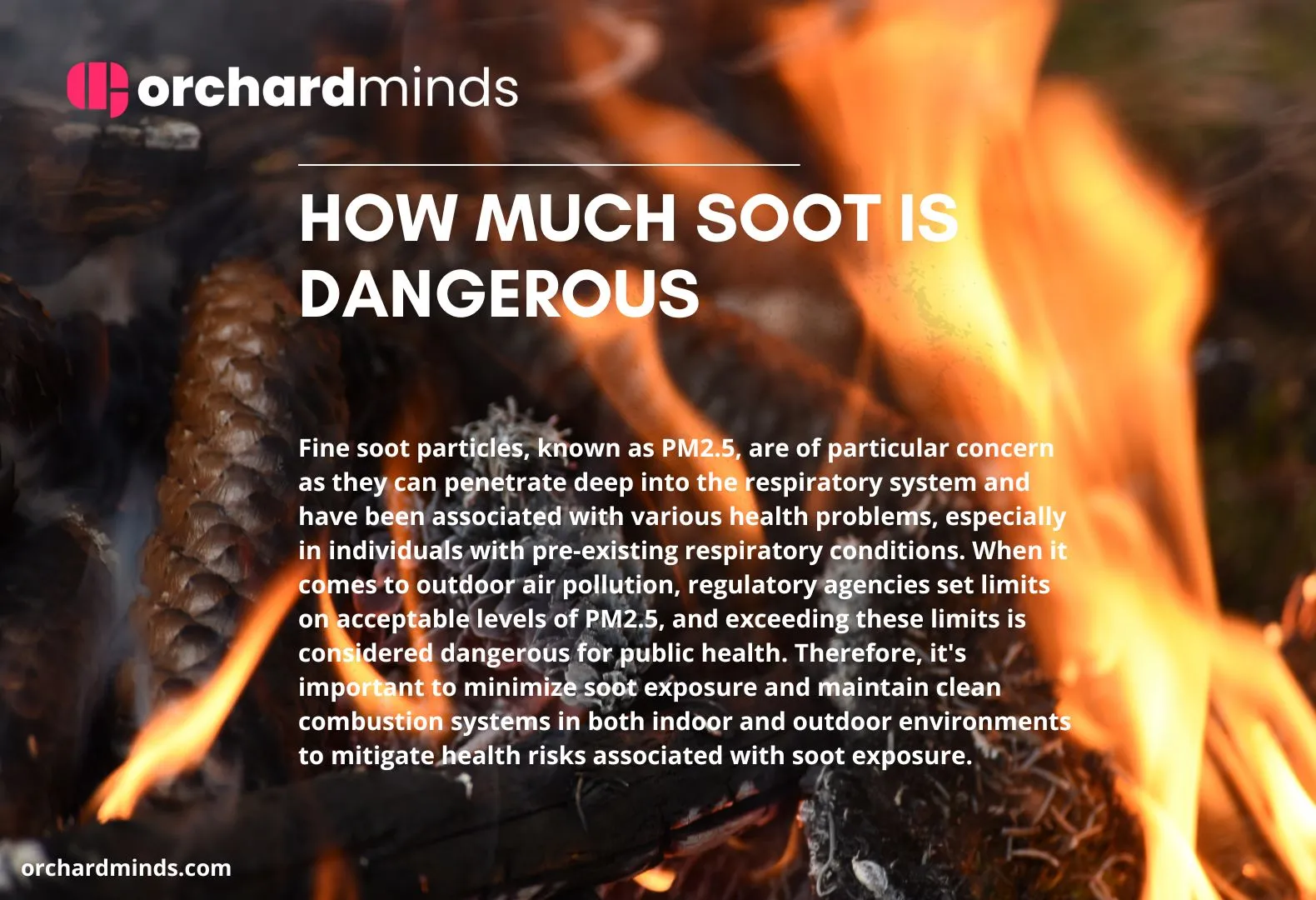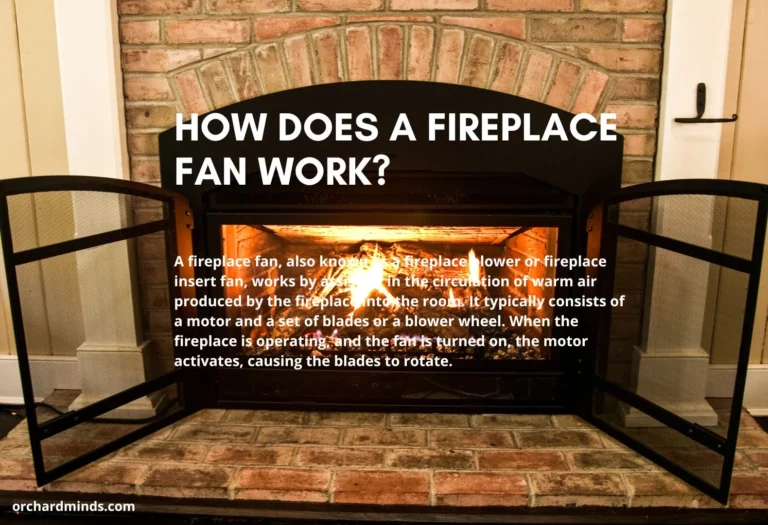How much soot is dangerous? The amount of soot considered dangerous can vary depending on the context and individual factors. In terms of indoor air quality, even small amounts of soot can contribute to respiratory irritation and health concerns. It’s not solely the quantity of soot that matters but also the type of particles it contains.
Fine soot particles, known as PM2.5, are of particular concern as they can penetrate deep into the respiratory system and have been associated with various health problems, especially in individuals with pre-existing respiratory conditions. When it comes to outdoor air pollution, regulatory agencies set limits on acceptable levels of PM2.5, and exceeding these limits is considered dangerous for public health. Therefore, it’s important to minimize soot exposure and maintain clean combustion systems in both indoor and outdoor environments to mitigate health risks associated with soot exposure.
Is Soot Dangerous? What You Should Know
Yes, soot can be dangerous. Soot is a black, carbonaceous substance that can result from incomplete combustion of organic materials such as wood, coal, oil, and gas. Soot particles can be very fine, known as PM2.5, and when inhaled, they can penetrate deep into the respiratory system, potentially causing or exacerbating health problems. Exposure to soot is associated with respiratory issues and cardiovascular problems and can pose significant health risks, especially to individuals with pre-existing conditions. In addition to its health implications, soot can contribute to air pollution and environmental concerns, making it essential to minimize soot emissions and maintain clean combustion systems to protect both public health and the environment.
What Is Soot?
Soot is a black, powdery, or flaky substance consisting of carbon particles that result from the incomplete combustion of organic materials such as wood, coal, oil, and gas. It is composed of fine carbon particles, often in the form of a black powder, and can vary in particle size. Soot is a byproduct of combustion processes and is commonly found in the exhaust gases of vehicles, industrial operations, and heating systems. While it has various industrial and environmental applications, soot can also pose health and environmental concerns when its emissions are not properly managed, as it can contribute to air pollution and respiratory health problems.
What Is Soot From Fire?
Soot from a fire is a black, powdery, or oily residue that forms during the combustion of organic materials, such as wood, paper, or other fuels. It consists primarily of fine carbon particles and other byproducts of incomplete combustion. Soot is a common byproduct of fires and can accumulate on surfaces, in chimneys, and the surrounding environment. It is often associated with open fireplaces, wood-burning stoves, and other heating sources. Excessive soot buildup in chimneys can be a fire hazard and should be regularly cleaned to prevent potential safety risks. Soot from a fire is not only an aesthetic concern but can also have environmental and health implications if not managed properly.
Where Is Soot Found Outside of A Fire?
Soot can be found in various places outside of a fire, and its presence is often linked to combustion processes, both natural and human-made. Here are some common locations where soot can be found outside of a fire:
- Exhaust Systems: Soot is a common byproduct of internal combustion engines in vehicles, industrial equipment, and power plants. It is found in exhaust gases and can accumulate in the exhaust systems of cars and machinery. This is a primary contributor to air pollution.
- Chimneys and Flues: Soot can build up in chimneys and flues used for heating and ventilation systems. In wood-burning stoves, open fireplaces, and furnaces, soot accumulates as a result of incomplete combustion and can pose a fire hazard if not removed through regular cleaning.
- Industrial Processes: Soot is produced in various industrial processes, such as the combustion of coal, oil, and natural gas for energy production, as well as in manufacturing operations like metal smelting and cement production.
- Environmental Sources: Forest fires, wildfires, and controlled burns release soot particles into the atmosphere. These particles can be transported over long distances, contributing to air pollution and affecting air quality in both urban and rural areas.
- Transportation: Diesel engines emit soot particles as a component of diesel exhaust. This type of pollution can impact air quality and pose health risks to those exposed.
- Cooking: In households that rely on solid fuels or open-flame cooking methods, such as wood or biomass stoves, soot can be produced during cooking processes. This can affect indoor air quality and may have health implications for those living in such environments.
- Natural Processes: Soot can also be found in naturally occurring processes, such as volcanic eruptions and geothermal activity. These events release fine ash particles and soot into the atmosphere, which can influence air quality and even global climate patterns.
Soot is a complex mixture of carbon particles and various chemical compounds, and its presence in these contexts can have environmental, health, and safety implications. Proper management and control of soot emissions are important to mitigate its effects on air quality, human health, and the environment.
What Are the Dangers of Soot Exposure?
Exposure to soot, especially fine particulate matter known as PM2.5, can pose various dangers to human health and the environment:
- Respiratory Problems: Inhaling soot particles can lead to a range of respiratory issues. Soot can irritate the airways and exacerbate pre-existing conditions like asthma, bronchitis, and chronic obstructive pulmonary disease (COPD). It can also cause shortness of breath, coughing, and wheezing.
- Cardiovascular Effects: Soot exposure is associated with an increased risk of heart problems. PM2.5 can enter the bloodstream and contribute to the development of heart diseases, including heart attacks, arrhythmias, and strokes.
- Decreased Lung Function: Prolonged exposure to soot can result in reduced lung function, particularly in children and older people. It may lead to diminished lung growth in children and accelerated lung function decline in adults.
- Cancer Risk: Certain compounds in soot are classified as potential human carcinogens. Long-term exposure to these substances, particularly in occupational settings, can increase the risk of lung cancer and other cancers.
- Environmental Impact: Soot is a significant contributor to air pollution, affecting both outdoor and indoor air quality. It can harm ecosystems, lead to acid rain, and contribute to climate change by reducing the reflectivity of snow and ice, leading to accelerated melting.
- Indoor Air Quality: Soot produced from indoor sources, such as wood-burning stoves, can lead to poor indoor air quality. This can affect occupants’ health, particularly in poorly ventilated spaces.
- Fire Hazards: Soot buildup in chimneys and exhaust systems can pose a fire hazard. Highly combustible, soot deposits can ignite if not properly managed or removed.
What Should I Keep In Mind When Removing Soot?
When removing soot, it’s essential to consider safety and proper cleaning techniques. Use personal protective equipment, including gloves and a mask, to minimize direct contact and inhalation of soot particles. Ventilate the area to disperse airborne soot and avoid respiratory exposure. Begin by gently dry-cleaning surfaces with a soft cloth or sponge to remove loose soot. Do not use water or liquid cleaners initially, as they can cause soot to spread or set in. If soot is embedded or stubborn, consult a professional for cleaning, especially in cases of extensive soot buildup or after a fire. Regular chimney and exhaust system maintenance can prevent soot accumulation in these areas.
How Do I Remove Soot?
To remove soot:
- Start by wearing personal protective equipment such as gloves and a mask.
- Begin with dry cleaning to remove loose soot, using a soft cloth, sponge, or a vacuum cleaner with a HEPA filter.
- Avoid using water or liquid cleaners at this stage, as they can cause soot to spread or set in.
- For more stubborn soot stains, consider using specialized soot or fireplace cleaner, following the manufacturer’s instructions. Suppose soot has accumulated in a chimney, fireplace, or exhaust system. In that case, it’s best to consult a professional chimney sweep or cleaner for safe and thorough removal, as these areas may require specialized tools and expertise.




Leave a Comment